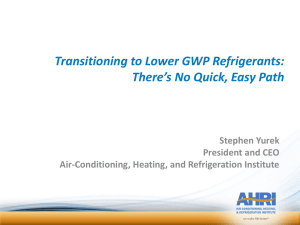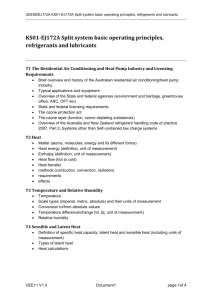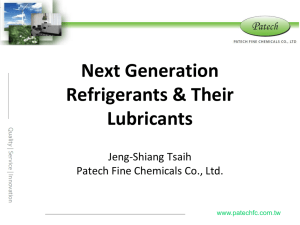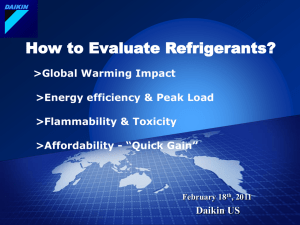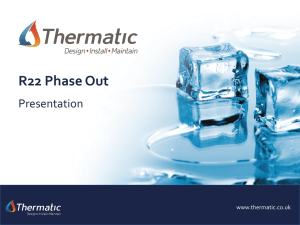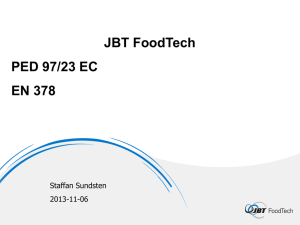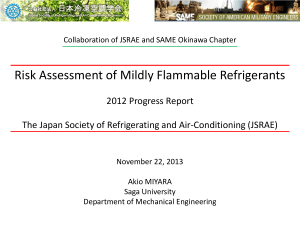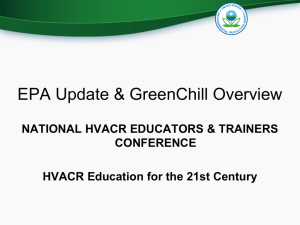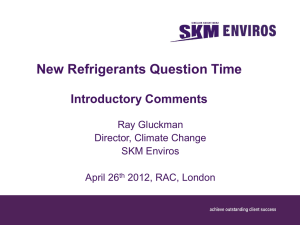Where Refrigerants are Heading in NZ
advertisement
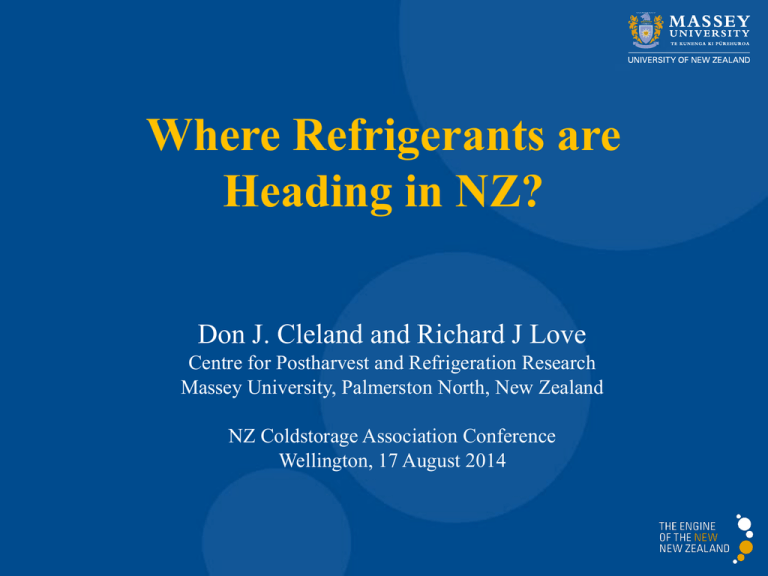
Where Refrigerants are Heading in NZ? Don J. Cleland and Richard J Love Centre for Postharvest and Refrigeration Research Massey University, Palmerston North, New Zealand NZ Coldstorage Association Conference Wellington, 17 August 2014 Overview • • • • • • • • Context The Perfect Refrigerant Alternative Refrigerants Alternative Technologies Future Options Lessons from the Past ETS Impacts & Challenges Conclusions & Recommendations 2 Introduction • • Enhanced work Health & Safety compliance after Pike River disaster and Christchurch earthquake Environmental pressures – – – – • growing population urban migration resource depletion standard of living expectations Ozone depletion – – – – – – caused by man-made chemicals including refrigerants response exemplary Montreal Protocol (MP) on track to solve phaseout of CFCs & HCFCs effectively no new HCFC imports from 2015 3 Global Warming • Evidence not certain – is there GW? – anthropogenic or natural effect? – magnitude & timeline of impacts • Scientific proof growing • Potential impact huge • Precautionary principle adopted – minimise and mitigate 4 Proof that the World is getting warmer 5 After a new research project with substantially increased budget the result was essentially the same: Kyoto Protocol • Basket of 6 gases – – – – – – CO2: fuel use CH4: decomposition N2O: agriculture SF4: electrical switchgear Perfluorocarbons:fire extinguishers & foams HFCs: refrigerants & foams • Does not cover MP gases • Stablise emissions for 2008-2012 to 108% of 1990 levels • GWP quantifies impact relative to CO2 7 Refrigeration & GW • Direct emissions (≈ 1%) – many refrigerants have high GWP – e.g. HFC-134a has GWP of 1300 • Indirect due to energy use (≈6%) – ≈0.6 kg CO2/kWh • ETS – 2 tonnes per unit in transition – ETS of initially $25/tonne CO2 equivalent – actual 2014 CO2 unit price of about $2-5/tonne CO2 4 Emissions Equivalent Mt CO2 – refrigeration about 15% of electricity demand – electricity generation about 40% of emissions Domestic Refrigeration Split Stationary Air Conditionerss Packaged Air Conditioners 3.5 3 Refrigerated Air Conditioners 2.5 Light Vehicle Air Conditioning Heavy Vehicle Air Conditioning Transport Refrigeration 2 1.5 Commercial Refrigeration 1 Commercial Air Conditioning Foam 0.5 Fire Fighting Equipment 0 1990 8 1995 2000 2005 Aerosol 2010 2015 Refrigerants Source: Danfoss 9 The Perfect Refrigerant Prosperity (Economic) People (Society) - low cost - high performance - energy efficient - safe - stable - wide material compatibility - low cost equipment - low GWP - safe o non-flammable o low pressure o distinctive colour or smell - low toxicity - energy efficient - low cost equipment Planet (Environment) - zero ODP - low GWP - energy efficient - low toxicity - unstable (short atmospheric life) 10 Refrigerant Families Criteria HCFCs HFCs HFOs NRs low/medium medium high low medium medium medium high Capacity good good good very good Energy Efficiency good good good very good ODP yes no no no GWP (ETS) high high low very low good generally good good except flammability often significant risks traditional synthetic synthetic wide Refrigerant Cost (no levy) System Cost Safety (e.g. flammability, toxicity, high pressure) Oil Compatibility 11 Refrigerant Formula ODP GWP Oil Compatibility 0.0 0.0 0.0 0.0 0.0 0.0 0.0 3260 POE 75 0.0 1530 POE 35 High glide 0.0 1730 POE 40 High P 0.0 1960 M,AB,POE 45 Medium glide 0.0 2620 M,POE 60 Medium glide CCl3F CCl2F2 115 (51%), 22 (49%) 1.0 1.0 0.23 R22 R123 CH Cl F2 C2H Cl2F3 0.055 0.02 R32 R125 R134a R143a R152a R245ca R507 CH2F2 C2HF5 C2H2F4 C2H3F3 C2H4F2 C3H3F5 125 (44%), 134a (4%), 143a (52%) 32 (23%), 125 (25%), 134a (52%) 32 (50%), 125 (50%) 125 (46.6%), 134a (50%), 600 (3.4%) 125 (65.1%), 134a (31.5%), 600a (3.4%) 125 (50%), 143a (50%) R1234yf R1234ze C3H2F4 C3H2F4 R218 C3F8 R170 - ethane R290 - propane R600a - isobutane R717 - ammonia R718 - water C2H6 C3H8 C4H10 NH3 H2O 3300 POE HFOs POE 0.0 4 0.0 6 POE Perfluorocarbons (PFs) 0.0 7000 Natural Refrigerants (NRs) 0.0 ~5 M,AB,POE 0.0 ~5 M,AB,POE 0.0 ~5 M,AB,POE 0.0 <1 M 0.0 <1 R744 – CO2 CO2 0.0 R1270 - propylene C3H6 0.0 R407C R410A R417A R422D Other Weaknesses CFCs 4000 8500 5590 HCFCs 1700 93 HFCs 650 2800 1300 3800 140 560 R11 R12 R502 R404A Levy ($/kg) M M M - MP phaseout MP phaseout MP phaseout M,AB M,AB,POE - MP phaseout MP phaseout POE POE,PAG 0.0 1 M 15 64 30 87 3 13 A2L A2L A2L 76 0.1 0.1 A2L, high cost High cost 161 Long EAL - A3 A3 A3 B2L, low P, no copper 0oC limit, very low P - 12 Low critical temp., high P - A3 ASHRAE Classification Source: Reindl, 2011 13 Oils 14 Alternative Technologies • Possibilities – – – – – – – acoustic magnetic thermo-electric (Peltier) vortex tube Brayton (air) cycle Stirling cycle absorption/adsorption • Issues – low efficiency – low capacity – high cost • Niche applications e.g. Peltier for low noise • Absorption if low cost heat 15 Improvements to Reverse Rankin Cycle • • • • • expanders multi-staging heat transfer enhancement variable speed technology transcritical if gas cooling matches process need • cascades & secondary refrigerants 16 Future Options • ETS cost for most HFCs incentivizes – reduction in leakage – reduction in charge – replacement with low GWP refrigerants • Likely replacements have concerns – performance (e.g. CO2) – cost (e.g. HFOs) – safety (e.g. HCs or HFOs) • Flammability harder to avoid 17 Total Impact TEWI (kg CO2) = direct refrigerant + indirect energy use = GWP M [x n + (1 - α)] + E n β LCCP (kg CO2) = TEWI + emissions due to manufacture where • • • • M = refrigerant charge (kg) x = leakage rate (% per year) n = equipment life (years) E = energy consumption (kWh/year) α = recovery factor (%) β = electricity emissions factor (kg CO2/kWh) Leakage & energy use seldom known accurately when refrigerant chosen & investing 5-20% leakage pa (Cowan et al., 2011) ETS converts environmental consideration into an economic one Net loss if lower GWP refrigerant has very poor energy efficiency 18 Leakage 19 Alternative Performance Refrigerant HFC-404A Alternative 3260 150 Charge (kg) 5 5 Leakage (% pa) 5 5 Energy Use (kWh pa) 25,000 +5% TEWI (kg CO2) 388,855 394,388 (+1.4%) 656+37,500 = 38,156 30+39375 = 39,405(+3.3%) GWP ETS + Energy Cost ($) o o o o 15 year equipment life 90% refrigerant recovery Electricity emission factor of 1 kg CO2/kWh Electricity cost of $0.1/kWh • If charge & leakage low, then GWP less important than efficiency 20 Relative Performance • Ammonia, HCs, CO2 (low temp.) often more efficient than HFCs (up to 10%) e.g. – theoretically R290 1-2% poorer than R22 – drop-in field trial gave 5-10% improvement for farm milk cooling (Cleland et al., 2009) • HFO1234yf close match to R134a • R32 & HFOs similar to R22 and R410A (high temp. applications) • R404A (low temp.) – R410A promising but moderate GWP & equipment constraints 21 Cascades & Secondaries • • • • • Use refrigerants in optimal temp. range Minimise & isolate charges of high GWP, flammable or toxic refrigerants “Safe” refrigerants or secondaries in populated areas e.g. glycol Energy penalty due to extra temp. difference and pumps CO2 likely low stage & secondary – – – – – • safe & low cost efficient low pumping power/pressure drop low mass & volumetric flows equipment availability & cost improving High stage refrigerants situation specific 22 Relative Performance System Capital Energy Annual Frozen Warehouse Complex;19,000 m2 Cost Energy Factor (Edwards, 2006, 2008) Life Cycle Costs (20 yr) DX R404A $2,500,000 1.2 $1,00,000 $25,250,000 DX Ammonia $3,063,000 1 $813,000 $22,063,000 Pumped Ammonia $3,125,000 0.8 $650,000 $17,625,000 Secondary CO2 $3,625,000 0.87 $706,000 $19,875,000 Secondary T40 $3,750,000 +$50,000 $756,000 $20,875,000 Cascade CO2 $3,375,000 0.84 $688,000 $19,250,000 Edwards (2006) 23 Lessons from the Past • • Concern that CFC alternatives less efficient & lower capacity Reality was little difference if wise choices – better heat transfer properties – better oils • • • • • • • • • • Initially many drop-ins but stabilized to manageable number of replacements Retrofits became routine Initially little thermodynamic & equipment performance data but rapidly rectified High glide refrigerants more challenging Material incompatibilities seldom acute High pressure R410A a concern! Extra costs passed onto customers Familiarity bred contempt after initial fear of the unknown Similar experience likely now but driven by cost rather than legislation Scandinavia since 2007 – low GWP refrigerants for large systems – proliferation of low charge systems 24 Past Future Predictions Application Automotive Air Cond. Domestic appliances Retail food - low temp - med. temp Chillers - centrifugal - reciprocating Insulating foams Industrial refrigeration Sector Domestic Refrigerator Commercial Equipment Medium Temperature Commercial Equipment Low Temperature Large Commercial & Industrial Mobile Air Conditioning or Refrigeration Air Conditioning Original R12 R12 R502 R12, R22, R502 R11 R12 R12 R11, R12 R22, R502, NH3 Compressor Type Sealed Unit Sealed Unit Accessible Hermetic Reciprocating Open Drive Sealed Unit Accessible Hermetic Reciprocating Open Drive Reciprocating Open Drive Centrifugal/Screw Reciprocating Open Drive Reciprocating Open Drive Centrifugal/Screw Accessible semi-Hermetic Replacements foreseen in 1990 Replacements foreseen in 1994 HFC-134a, blends HFC-134a, blends HCFC-22, HFC-125 HCFC-22,HFC-134a HFC125, blends HCFC-123 HFC-134a, blends HFC-134a, HCFC-22, blends HCFC-123,HCFC-22 HCFC-22, NH3 HFC-134a HFC-134a, R290 HFC-507, HFC-404A HFC-134a, HFC-507 HFC-404A Blends HFC-134a HFC-134a Source: Lommers, 2003 various HFC-507, HFC-404A, NH3 Refrigerant R134a, R401A, R409a, R413a R134a, R22, R401A1, R404A, R407A, R409A, R413A, R507 R134a, R22, R401A2, R404A, R407C, R413A, R507 R134a, R22, R401A2, R404A, R407C, R409A2, R413A, R507 R22, R402A, R402B, R403A, R404A, R407B, R408A, R410A, R507 R22, R402B, R403A, R404A, R407B, R408A, R410A, R507 R22, R402A, R402B, R403A, R404A, R407B, R408A, R410A, R507 R22, R134a, R401A, R401B, R402A, R403A,R404A, R407B4, R407C4, R408A, R409A,R410A, R413A, R507, R717 R134a, R123, possibly R1243 , R22, R407A4, R401A4, R717 R22, R134a, R401C, R402A, R403A,R404A, R407C, R408A, R409A, R409B,R416A, R507, possibly R22 R22, R134a, R401A, R409A, R410A,R413A R134a, R123, R22, R410A R22, R123, R134a, R401B, R404A, R407C, R409B, R410A, R507 25 Pathways – Past & Future CFCs HCFCs HFCs HFOs/NRs Comments 11 123 134a 245ca 1234yf 717 low charge 134a 1234yf 600a low charge 717 744 HFO? low stage of cascade blends? 12 502 Pre-1990 404A 507 22 404A 407C 507 410A 417A 422D Pre-2005 Pre-2012 HFO? blends? 717 744 if water heating needed 744 low stage of cascade 170+290 low charge HFC-32 low charge 170+290 low charge 744 low stage of cascade HFO? blends? Post-2012 26 ETS Impacts & Challenges • Cost will be passed onto customers • Potential for increased margins • Incentives for – – – – – good practice (reducing charge & leakage) life cycle costing & impacts assessment innovative design & service practice early replacement of older less efficient plant development of skills to work with flammable refrigerants • Disadvantages – higher refrigerant inventory costs – higher risk of refrigerant theft – higher business risk if ignorant about issues & alternative refrigerants – incentives to delay R22 replacement – uncertainty about availability and cost of HFOs in the short term – poorer customer relations due to poor understanding of ETS – greater number of refrigerants in short term 27 Barriers • Surveys by Burhenne & Chasserot (2011) and Colbourne (2011) – knowledge levels – technology availability – safety concerns and related psychological factors – too restrictive regulations and standards 28 Conclusions The ETS on refrigerants will – increase costs – provide incentives for best practice – enhance commercial opportunities for well-informed and proactive customers & service providers – increase consideration of NR options – provide the chemical industry motivation to develop efficient & safe synthetic alternatives – provide an opportunity for the refrigeration industry to lift its performance – not be a significant threat 29 Recommendations • • • • • • • • Reduce refrigerant charges in new systems Increase tightness of existing systems Expect flammable refrigerants so understand the risks Keep informed about environmental issues & refrigerant options & performance Use a life cycle costing approach so long term focus Shift to lower GWP refrigerants when significant system changes are needed Carefully plan and schedule replacement of existing large R22 systems (short term delay may be astute) Try to use NRs if safety issues can be addressed costeffectively 30 Back to the Future? ©2008 Risto Ciconkov 31 Questions d.cleland@massey.ac.nz References 1. 2. 3. 4. 5. 6. 7. 8. 9. Burhenne, N., Chasserot, M. (2011) Natural refrigerants in the HVAC&R industry – a study of global market and policy trends. Proceedings International Congress of Refrigeration, Prague, Czech Republic, August 2011, paper 147. Calm, J.M., Hourahan, G.C. (2011) Physical, safety and environmental data for current and alternative refrigerants. Proceedings International Congress of Refrigeration, Prague, Czech Republic, August 2011, paper 915. Cleland, D.J., Keedwell, R.W., Adams, S.R. (2009) Use of hydrocarbons as drop-in replacements for HCFC-22 in on-farm milk cooling equipment, International Journal of Refrigeration 32: 1403-1411. Colbourne, D. (2011) Barriers to the uptake of low GWP alternatives to HCFC refrigerants in developing countries. Proceedings International Congress of Refrigeration, Prague, Czech Republic, August 2011, paper 628. Cowan, D., Lundqvist, P., Maidment, G., Chaer, I. (2011) Refrigerant leakage and constainment – overview of the activities of the IIR working party on mitigation of direct emissions of greenhouse gases in refrigeration. Proceedings International Congress of Refrigeration, Prague, Czech Republic, August 2011, paper 856. DCCEE (2012), Australian National Greenhouse Accounts: National Inventory Report 2010, Department of Climate Change and Energy Efficiency, Canberra, http://www.climatech ange.gov.au/emissions Edwards, B.F. (2006) CO2 refrigeration. Presented at IIR-IRHACE 2006 Conference, Auckland, NZ, 16-18 February, 2006. Edwards, B.F. (2008) Personal communication; Realcold Ltd, New Zealand Lommers, C.A. (2003). Air-Conditioning and Refrigeration Refrigerant Selection33 Guide - 2003, AIRAH, Melbourne.
